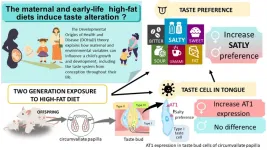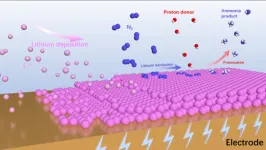(Press-News.org) Researchers at NYU Grossman School of Medicine and Janssen Biotech, Inc. have shown in early tests that a bioengineered drug candidate can counter infection with Staphylococcus aureus – a bacterial species widely resistant to antibiotics and a major cause of death in hospitalized patients.
Experiments demonstrated that SM1B74, an antibacterial biologic agent, was superior to a standard antibiotic drug at treating mice infected with S. aureus, including its treatment-resistant form known as MRSA.
Published online April 24 in Cell Host & Microbe, the new paper describes the early testing of mAbtyrins, a combination molecule based on an engineered version of a human monoclonal antibody (mAb), a protein that clings to and marks S. aureus for uptake and destruction by immune cells. Attached to the mAb are centyrins, small proteins that prevent these bacteria from boring holes into the human immune cells in which they hide. As the invaders multiply, these cells die and burst, eliminating their threat to the bacteria.
Together, the experimental treatment targets ten disease-causing mechanisms employed by S. aureus, but without killing it, say the study authors. This approach promises to address antibiotic resistance, say the researchers, where antibiotics kill vulnerable strains first, only to make more space for others that happen to be less vulnerable until the drugs no longer work.
“To our knowledge, this is the first report showing that mAbtyrins can drastically reduce the populations of this pathogen in cell studies, and in live mice infected with drug-resistant strains so common in hospitals,” said lead study author Victor Torres, PhD, the C.V. Starr Professor of Microbiology and director of the NYU Langone Health Antimicrobial-Resistant Pathogen Program. “Our goal was to design a biologic that works against S. aureus inside and outside of cells, while also taking away the weapons it uses to evade the immune system.”
One-third of the human population are carriers of S. aureus without symptoms, but those with weakened immune systems may develop life-threatening lung, heart, bone, or bloodstream infections, especially among hospitalized patients.
Inside Out
The new study is the culmination of a five-year research partnership between scientists at NYU Grossman School of Medicine and Janssen to address the unique nature of S. aureus.
The NYU Langone team together with Janssen researchers, published in 2019 a study that found that centyrins interfere with the action of potent toxins used by S. aureus to bore into immune cells. They used a molecular biology technique to make changes in a single parental centyrin, instantly creating a trillion slightly different versions of it via automation. Out of this “library,” careful screening revealed a small set of centyrins that cling more tightly to the toxins blocking their function.
Building on this work, the team fused the centyrins to a mAb originally taken from a patient recovering from S. aureus infection. Already primed by its encounter with the bacteria, the mAb could label the bacterial cells such that they are pulled into bacteria-destroying pockets inside of roving immune cells called phagocytes. That is unless the same toxins that enable S. aureus to drill into immune cells from the outside let it drill out of the pockets to invade from the inside.
In a “marvel of bioengineering,” part of the team’s mAbtyrin serves as the passport recognized by immune cells, which then engulf the entire, attached mAbtyrin, along with its centyrins, and fold it into the pockets along with bacteria. Once inside, the centyrins block the bacterial toxins there. This, say the authors, sets their effort apart from antibody combinations that target the toxins only outside of cells.
The team made several additional changes to their mAbtyrin that defeat S. aureus by, for instance, activating chain reactions that amplify the immune response, as well by preventing certain bacterial enzymes from cutting up antibodies and others from gumming up their action.
In terms of experiments, the researchers tracked the growth of S. aureus strains commonly occurring in US communities in the presence of primary human immune cells (phagocytes). Bacterial populations grew almost normally in the presence of the parental antibody, slightly less well in the presence of the team’s engineered mAb, and half as fast when the mAbtyrin was used.
In another test, 98% of mice treated with a control mAb (no centyrins) developed bacteria-filled sores on their kidneys when infected with a deadly strain of S. aureus, while only 38% of mice did so when treated with the mAbtyrin. Further, when these tissues were removed and colonies of bacteria in them counted, the mice treated with the mAbtyrin had one hundred times (two logs) fewer bacterial cells than those treated with a control mAb.
Finally, the combination of small doses of the antibiotic vancomycin with the mAbtyrin in mice significantly improved the efficacy of the mAbtyrin, resulting in maximum reduction of bacterial loads in the kidneys and greater than 70% protection from kidney lesions.
“It is incredibly important,” said Torres, “that we find new ways to boost the action of vancomycin, a last line of defense against MRSA.”
Along with Torres, authors from the Department of Microbiology at NYU Langone were Rita Chan, Ashley DuMont, Keenan Lacey, Aidan O’Malley, and Anna O'keeffe. The study authors included 13 scientists from Janssen Research & Development (for details see the study manuscript).
This work was supported by Janssen Biotech, Inc., one of the Janssen Pharmaceutical Companies of Johnson & Johnson, under the auspices of an exclusive license and research collaboration agreement with NYU. Torres has recently received royalties and consulting compensation from Janssen and related entities. These interests are being managed in accordance with NYU Langone policies and procedures.
END
New biologic effective against major infection in early tests
2023-04-24
ELSE PRESS RELEASES FROM THIS DATE:
Researchers develop new tools for precise large DNA insertions
2023-04-24
GAO Caixia's group from the Institute of Genetics and Developmental Biology of the Chinese Academy of Sciences (CAS) has developed a new genome editing technology that achieves efficient and precise targeted insertion of large DNA segments in plants.
The new technology, called prime editing-mediated recombination of opportune targets (PrimeRoot), combines an optimized dual-ePPE editor protein previously published by the group with a highly efficient tyrosine site-specific recombinase, Cre. It can achieve ...
Researchers ID novel treatment pathway for deadly pancreatic cancers
2023-04-24
Researchers at the Johns Hopkins Kimmel Cancer Center identified a novel cell signaling pathway that potentially could be targeted in therapy for patients with aggressive pancreatic cancers.
In laboratory studies with human pancreatic cancer cell lines and genetically engineered mouse models of pancreatic cancer, the investigators discovered that the High Mobility Group A1 (HMGA1) protein functions as a “molecular switch” that “flips on” genes required by tumor cells to grow in an uncontrolled fashion and form invasive tumors. One of these genes activated ...
Maternal and early-life high-fat diets result in a taste for salty food
2023-04-24
Tokyo, Japan – We are all aware of the importance of eating healthy food, especially during pregnancy. A high-fat diet has dramatic consequences on the metabolism. It can lead to obesity, diabetes, chronic liver disease, and possibly cancer. Previous works have demonstrated that eating high amounts of fat during pregnancy affects the taste preference and metabolism in offspring. In most households, children and parents eat the same food. In other words, mums eating a high-fat diet will likely feed their children fatty foods. What are the consequences of maternal ...
NFL PLAY 60 Fitness Break broadcast keeps kids active in advance of the NFL Draft
2023-04-24
DALLAS, April 24, 2023 — The American Heart Association and the National Football League (NFL), in collaboration with its 32 NFL clubs, are challenging kids to move more with an NFL PLAY 60 Fitness Break for the NFL Draft happening later this week. The free program on Wednesday, April 26 at 1 p.m. ET/ 12 p.m. CT/ 10 a.m. PT will offer a 15-minute synchronous broadcast to help students learn how to add movement to their day leading up to the live Draft coverage from Kansas City.
Rooted in American Heart Association science, the Fitness Break broadcast helps students learn more about how physical activity supports ...
A panoramic view on lithium-mediated electrochemical dinitrogen reduction reaction
2023-04-24
The Haber-Bosch process is the industrial approach for NH3 production today, which must be operated at energy-intensive high temperatures and pressures. The reduction of dinitrogen (N2) by electrocatalysis offers an alternative way for NH3 production at ambient conditions and a variety of electrocatalysts have been studied over the past few years. However, even the best catalytic system reported could only get unsatisfied performance (such as the selectivity and production rate of NH3) due to the ...
Unveiling a fast and efficient method for detecting microRNAs
2023-04-24
In the early 1990s, scientists who were studying the development of a roundworm identified a small RNA molecule that regulated the expression of specific genes. This marked the discovery of microRNAs (miRNAs), which are now known to be present across all forms of life. As it turns out, these molecules play essential roles in many biological processes.
A few years later, researchers realized that diseases could dysregulate the expression of miRNAs, highlighting their potential as biomarkers. In fact, abnormal miRNA expression is a hallmark of all tumor-related diseases. Thus, miRNA detection techniques ...
Research sheds light on minimally invasive neurosurgery approach
2023-04-24
Brain tumors located in regions that control speech, vision and motor function present additional challenges to neurosurgeons, as damaging the surrounding tissue can cause severe loss of those abilities.. Because of this, these regions are known as “eloquent brain areas” and require special attention and approaches to limit damage and deficits.
The University of Cincinnati’s Paolo Palmisciano, MD, was part of a research team that examined how well a minimally invasive approach worked to limit vision and hearing loss in patients following brain tumor surgery.
The research was published in the journal Brain Sciences, and the ...
New report makes recommendations on controversial genetics research
2023-04-24
The report, “Wrestling with Social and Behavioral Genomics: Risks, Potential Benefits, and Ethical Responsibility,” produced by The Hastings Center, a bioethics institute, provides direction for research and communications in this area of study with both significant social risks and potential benefits. It is accompanied by an article that describes a fledgling effort to integrate community perspectives on the ethics of this research.
A webinar to launch the consensus report will take place today at 3 PM EST. Register here.
Research on genetic variants and human social and behavioral characteristics, or phenotypes, including anxiety, subjective well-being, ...
Multiple-model GWAS identifies optimal allelic combinations of quantitative trait loci for malic acid in tomato
2023-04-24
The objective of this study is to identify these loci and decipher the polygenic architecture of malic acid content in tomato fruit. The authors carried out a GWAS using six milestone models with two-environment repeats. A series of associated SNP variations were identified from GWAS, and 15 high-confidence annotated genes were obtained based on the lead SNPs and the malic acid accumulation. The optimal allelic combination of the 15 loci was presented for tastier tomato. ...
120-year-old storm’s secrets key to understanding weather risks
2023-04-24
A severe windstorm that battered the UK more than a century ago produced some of the strongest winds[OS1] that Britain has ever seen, a team of scientists have found after recovering old weather records.
Old weather measurements, first recorded on paper after Storm Ulysses hit the UK in February 1903, have shed new light on what was one of the most severe storms to have hit the British Isles.
By turning hand-written weather data into digital records, the research team has laid the way to better understand other historical storms, ...






